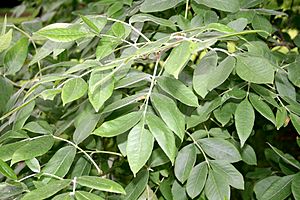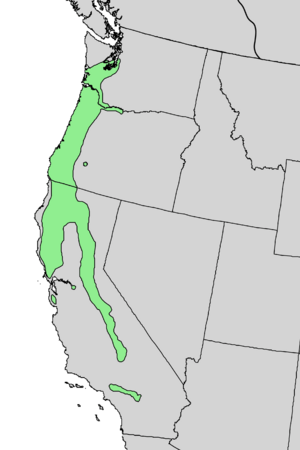Oregon ash facts for kids
Quick facts for kids Oregon ash |
|
|---|---|
 |
|
| A mature tree at the Meise Botanic Garden | |
 |
|
| Leaves of the Oregon ash | |
| Conservation status | |
| Scientific classification | |
| Genus: |
Fraxinus
|
| Species: |
latifolia
|
 |
|
| Native range | |
| Synonyms | |
|
Fraxinus oregona |
|
The Oregon ash (scientific name: Fraxinus latifolia) is a type of tree that belongs to the ash family. It grows naturally in western North America.
Contents
What is the Oregon Ash Tree?
The Oregon ash is a medium-sized tree that loses its leaves every year (it's deciduous). It can grow to be about 20 to 25 meters (65 to 82 feet) tall. Its trunk can be 40 to 75 centimeters (16 to 30 inches) wide. These trees usually live for 100 to 150 years. In good conditions, they can live much longer, even over 200 years! But in dry places, they might stay small.
When an Oregon ash tree grows in an open area, its top part (called the crown) can spread out very wide. This is similar to a bigleaf maple tree. If it grows in a crowded forest, its crown stays narrow, like a red alder tree.
Leaves and Bark
The bark of the Oregon ash is easy to spot. It's dark gray-brown and develops deep cracks and ridges that look like a woven pattern.
The leaves are made up of several smaller leaflets, like a feather. They are 12 to 33 centimeters (5 to 13 inches) long. Each leaf has 5 to 9 leaflets attached in pairs, with one extra leaflet at the very end. Each small leaflet is shaped like an oval, about 6 to 12 centimeters (2.5 to 5 inches) long and 3 to 4 centimeters (1 to 1.5 inches) wide.
Oregon ash leaves are a lighter green than other trees around them. In autumn, they turn bright yellow and fall off early. Sometimes, the leaves and bark might show signs of disease, even if the tree is healthy.
How to Identify Oregon Ash in Winter
After the leaves fall in autumn, you can still tell an Oregon ash tree apart. Look for its strong twigs and how its branches and buds grow directly opposite each other. Unlike bigleaf maples, ash twigs have soft, woolly hairs.
Flowers and Reproduction
In spring, the tree grows small flowers that are hard to notice. Oregon ash trees are "dioecious." This means that each tree is either male or female. You need both a male and a female tree nearby for them to make seeds.
Female trees produce the fruit, which are called "samaras." These are like small, winged seeds, similar to those found on maple trees. They are 3 to 5 centimeters (1 to 2 inches) long and shaped like a canoe, with the seed at one end. The wings help the seeds fly away in the wind.
Where Oregon Ash Trees Live
You can find Oregon ash trees on the west side of the Cascade Range. They grow from southwestern British Columbia down through western Washington, western Oregon, and northwestern California. They also grow in central California in the Sierra Nevada mountains.
Habitat
Oregon ash trees love wet places. They prefer damp, loose soils found in areas like:
- Sloughs (muddy channels)
- Swales (low, wet areas)
- Wet meadows
- Swamps
- Along streams
- In bottomlands (low-lying land along a river)
They can grow from sea level up to about 900 meters (3,000 feet) high. In the southern parts of California, they can be found even higher, up to 1,700 meters (5,600 feet). In central Southern California, Oregon ash trees mix with another type of ash called velvet ash.
How Oregon Ash Trees Grow and Survive
Oregon ash trees do not like a lot of shade. They might eventually be replaced by trees like bigleaf maples or fir trees that block the sunlight. This tree grows best when its home becomes more open. This can happen after floods, strong winds that blow down other trees, or other natural events.
If an Oregon ash tree is cut down or burned by fire, it can grow new sprouts very quickly from its stump. Young trees grow fast for about 60 years, then their growth slows down.
Root System and Resilience
This type of ash tree is very good at living in soggy ground. It has roots that are not very deep but spread out wide. This strong root system also helps the tree stand up well against strong winds. Oregon ash can handle flooding much better than Douglas-fir or grand fir trees.
Food for Wildlife
Oregon ash trees provide food for many animals. Their seeds are eaten by songbirds, squirrels, and waterfowl (like ducks). Deer and elk are also known to eat the leaves and young sprouts of the tree.
Uses of Oregon Ash
The wood from Oregon ash is very good, similar to the valuable wood from ash trees in eastern North America. However, it's not used as much for lumber because there isn't as much of it available.
Traditional Uses
The Cowlitz Indian Tribe used the wood from Oregon ash to make canoe paddles and digging sticks. Later, European settlers also preferred similar types of ash wood for things like tool handles and sports equipment.
Wood Qualities
The wood of the Oregon ash is light in color and a bit shiny. It is hard, strong, and flexible. It can handle shocks well and is easy to work with machines. It also wears smoothly with use.
Young, fast-growing ash wood is more flexible. This makes it better for things like tool handles and baseball bats. Older ash trees are often used for firewood because their wood has a fine grain and breaks easily.
Modern Uses
Oregon ash is often planted as an ornamental tree or a shade tree in yards and parks. People like it because it grows fast, has a nice shape, and is very tough. It's also used to create windbreaks and to help restore areas along rivers because of its wide root system and quick growth.
See also
In Spanish: Fresno de Oregón para niños


